Good Fortune & Great Sights in Aizu
Aizuwakamatsu, the Samurai city. When you walk around the small city, you can see its retention of history and what used to be the former castle town of the Aizu domain. From the red tiled roof of Tsuruga Castle, the Aizu festival, or even the Nishin-kan, a former reputable samurai school of the Edo period, one can capture a glimpse of the samurai spirit alive and well.
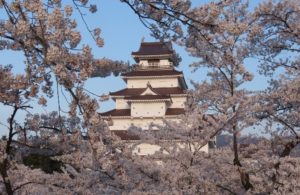 But did you know that this area was also once called Buddhist Capital Aizu? Aizu was one of the first areas in Tohoku where Buddhism flourished leaving behind many statues and temples since the Heian period (794 AD~1185 AD).
But did you know that this area was also once called Buddhist Capital Aizu? Aizu was one of the first areas in Tohoku where Buddhism flourished leaving behind many statues and temples since the Heian period (794 AD~1185 AD).
One can gain a sense of spirituality and discover the natural beauty that can be found in and around Aizu through the Aizu 33 Kannon pilgrimage.
The Aizu 33 Kannons are generally statues of the 33 images of the goddess of compassion and mercy. However, these Kannons can range from stone statues in mountains, to enshrined Japan National Treasures. The pilgrimage to these 33 Kannons was established by Hoshina Masayuki back in the 17th century, and made popular through improvement of roads and inns in the area around the Kannons.
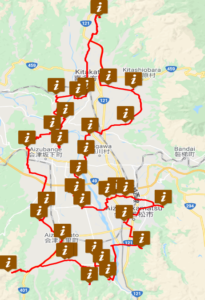 This route is still popular with the Aizu locals to this day for not just spiritual purposes, but also the beautiful scenery, temples and statues. It is also popular to partake in the local delicacies and hot springs nearby in some of the old towns and villages surrounding the Kannons.
This route is still popular with the Aizu locals to this day for not just spiritual purposes, but also the beautiful scenery, temples and statues. It is also popular to partake in the local delicacies and hot springs nearby in some of the old towns and villages surrounding the Kannons.
Don’t be fooled into thinking that there are only 33 Kannons in the area though. There are in fact more than that which are located as far as the lake side town of Inawashiro, the northern city of Kitakata, or the southern small town of Minamiaizu.
The Aizu pilgrimage in a way has recently had a more relaxed and leisurely nature as compared with other pilgrimages in Japan. Whether it’s a simple singular visit to appreciate views and peacefulness, or even spending a whole couple of months visiting all sites, like the people of old Aizu to gain good fortune.
If you are the latter, many of the shrines are widely spread out, and it can be daunting to try and link all 33 Kannon in a short period of time. The shortest amount of time as it seems would be 2 days by bicycle.
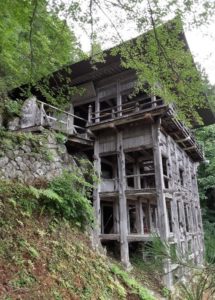 Guided tours are also available for a premium price. If you lack the time and still think a pilgrimage is of interest, a visit to the Sazaedo is the answer. The Sazaedo is a temple with a double helix structure, the last of its kind. It houses all 33 images of Kannon within the building and is said to have the same benefits as visiting all 33 Aizu Kannon. Thus, if good fortune is what you seek, then you’re not out of luck.
Guided tours are also available for a premium price. If you lack the time and still think a pilgrimage is of interest, a visit to the Sazaedo is the answer. The Sazaedo is a temple with a double helix structure, the last of its kind. It houses all 33 images of Kannon within the building and is said to have the same benefits as visiting all 33 Aizu Kannon. Thus, if good fortune is what you seek, then you’re not out of luck.
The true value of visiting even one of these places I feel though is the low-key atmosphere and great views that help sooth the mind and heart. Upon my travels in Aizuwakamatsu, I myself had unknowingly stumbled upon some of the Kannons, during my search for a place to collect my thoughts.
One example was the Takizawa Kannon (Pictured below). It is a shrine tucked away in the mountains about a 30-minute walkaway from Iimoriyama. It starts with a stair leading down pathway flanked by numerous flags before making it to the main shrine area.
Beside the shrine is the Shiraito waterfalls in the background which give the area an aura of tranquility as you take in the sounds of running water and the mountain greenery. I had spent 2 hours just sitting, watching and listening to the sounds of nature without a single soul passing by. It was very healing in its own way.
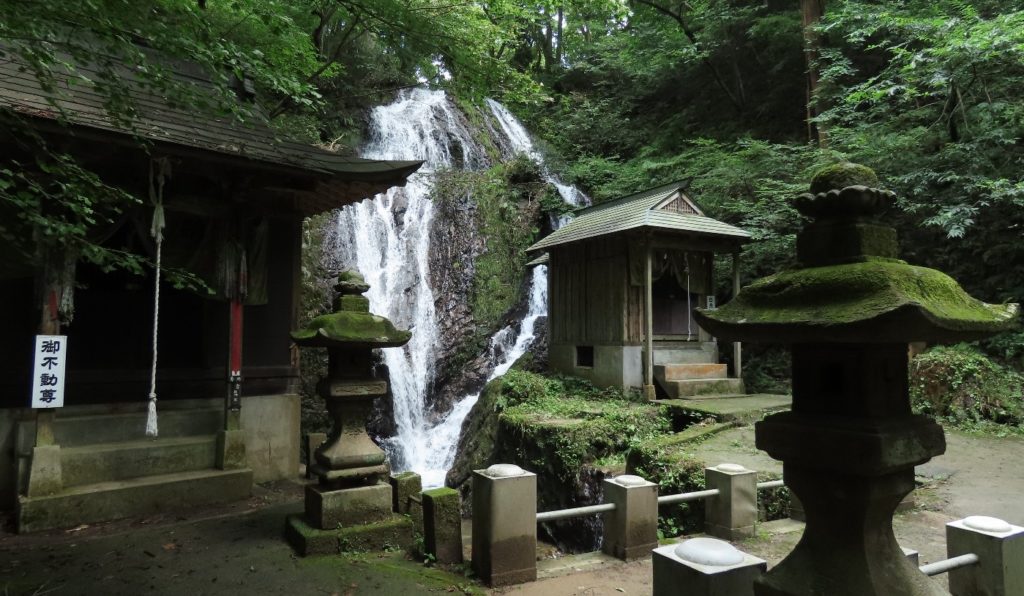
I have also visited the Sakudari Kannon (pictured above to the right) after a leisurely bike ride, which features a temple partially built inside a mountain and also boasts a great vista overlooking the Aizuwakamatsu area.
The 33 Aizu Kannons feature some of the more stunning landscapes of Aizu. From waterfalls, forests, mountain vistas, to temple caves, the visits are worthwhile. If you find yourself in the Aizu area, looking for adventure, a quiet place, or something to do while you walk about the older parts, the Aizu Kannons are for you. Whether your goal is to visit all 33, or to truly enjoy just one, good fortune and good views are waiting for you anytime.
Your next adventure could take you to Aizuwakamatsu not just to visit, but to live and work there! For more information, read all about being an ALT!
Photo credits:
Additional images for this article were provided by the original author, used with permission
All other content (text) created by the original author and © 2021 MUSUBI by Borderlink
“Our visit taught me that it pays to understand the cultural impact and the influence of tradition to the things we enjoy and sometimes even take for granted nowadays.”
When we talk about art, some images immediately comes to mind: Paintings, sculptures, and decorative vases from centuries ago. Most of them have similar characteristics: they cannot be touched, they cannot be used and are for your eyes only.
But what if I were to tell you that there exists a form of artwork in Japan that was so powerful it inspired and motivated even the great Impressionist artists such as Monet and Van Gogh? Its influence so vast that it became a part of the “Blue Revolution” and ultimately inspired the concepts of an existing form of ‘usable art’: Hokusai Graphic.
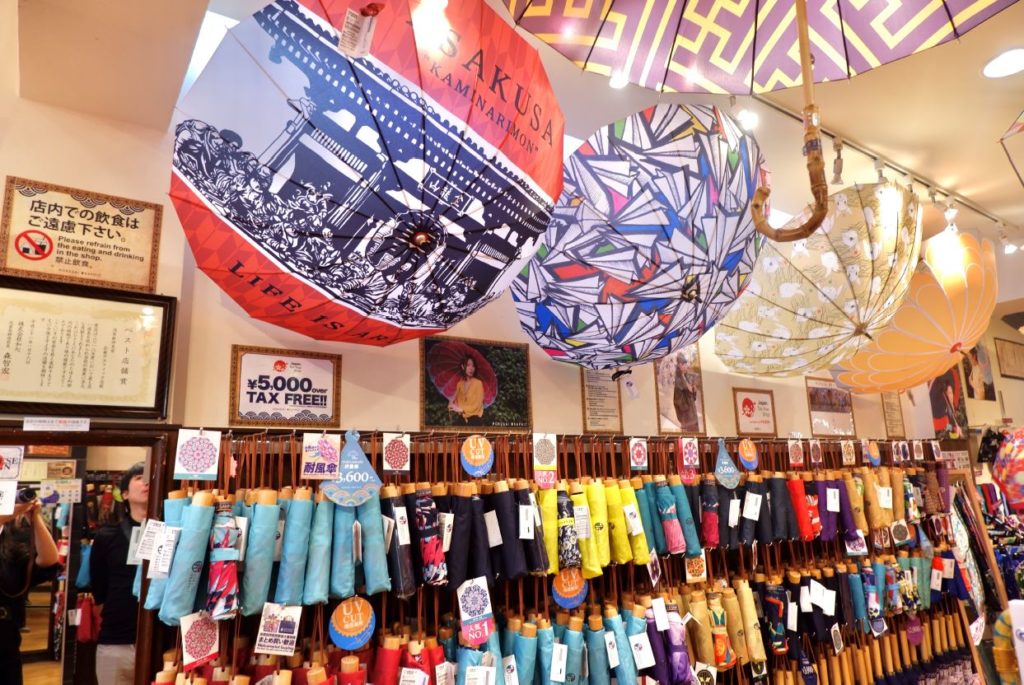
From a glance, you may notice Hokusai Graphic stores all over Japan. The beautiful array of colors and designs may even catch your eyes for a moment without you realizing what you’re looking at. For you are staring at artworks inspired by the world-renowned Japanese artist and Ukiyo-e painter Katsushika Hokusai.
We decided to see for ourselves the beauty of such usable art or in many cases, wearable art. And where else is the perfect store to visit if not in Asakusa, one of the pinnacles of fashion on the planet? A trip there is another one to add to your bucket list. Here is our experience.
Inside the store you will find different arrays of umbrellas, raincoats and even Yukata. The ones which are particularly popular among women lately are products with handles made from natural bamboos. They also offer different Hokusai patterns from flowers to landscapes to sumo wrestlers. What I loved most is their “un-tout-cas” umbrellas which combines the look of an umbrella and a parasol.
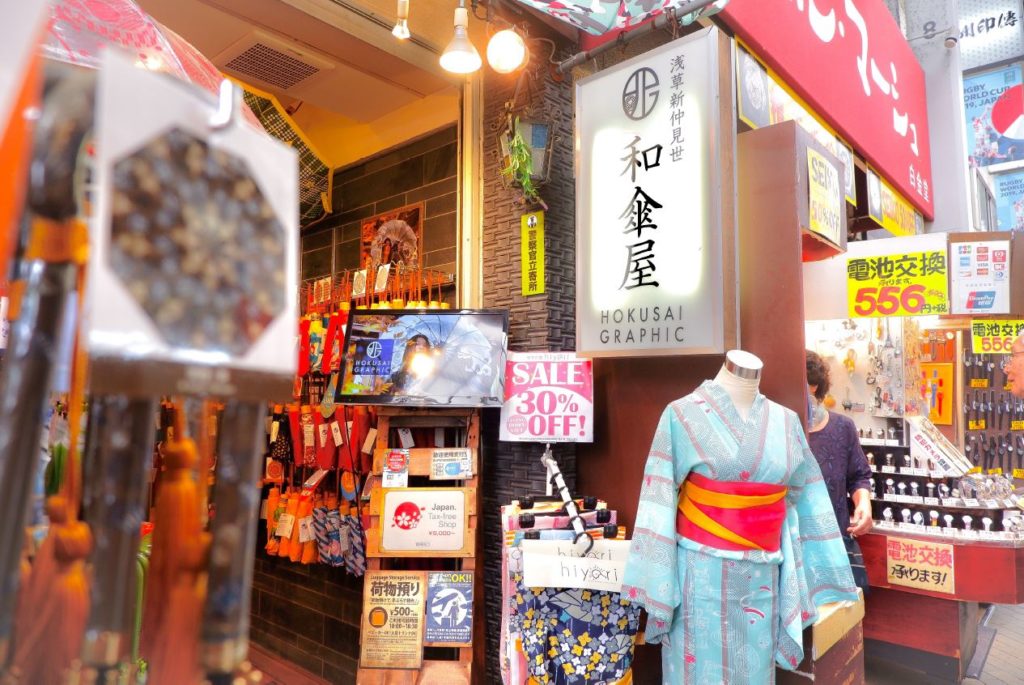
One of the things I also would like to highlight is how inclusive their store is when it comes to gender. They also offer a vast array of umbrellas with colors and patterns suitable for men.
One of the staff we interviewed shares that their designing process is very traditional that it undergoes more than 100 stages and some of the umbrellas even includes the use of “Washi” or traditional Japanese papers. We also learned that the use of umbrellas flourished through the influence of “Sukeroku” or “The Flower of Edo” which was a Kabuki performance during the Edo era which made use of umbrellas.
I think it is true that you can never truly tell the value of a thing just by taking it at face value. Sometimes, it pays to dig deeper and understand the cultural importance and the influence of tradition to the things we enjoy and sometimes even take for granted nowadays. To start your dig, I recommend checking out the Hokusai Graphic store in Asakusa for yourself, and see what treasures you find.
Photo Credits:
All photos for this article were provided by Zygel Doll Jamelano and used with permission.
An expanded version of this article is also available on Zeefinity.
All other content (text) created by the original author and © 2021 MUSUBI by Borderlink
Top Photo: “Monjayaki” by Masaaki Komori from Tokyo, JAPAN licensed under the Creative Commons Attribution-Share Alike 2.0 Generic license (CC BY-SA 2.0). No changes or alterations made. Wikimedia Commons Link
While Sushi remains a number one favorite Japanese food, and deservedly so, it has become so well-known around the world that you hardly need to visit Japan to try it. How would you like to try a Japanese cultural food that is both popular in Japan yet localized and rare? You really need to have the fun of trying Monjayaki!
As monjayaki has become more popular, you can perhaps find it in various places around Japan that also serve the more famously-known okonomiyaki. But if you really want to enjoy it in its original old-time atmosphere, you should come to my neighboring island in Tokyo Bay, Tsukishima (Moon Island).
Tukishima is a man-made island within walking distance of Ginza. It was completed in 1892. One great thing about Tsukishima is that it is very close to St. Luke’s hospital, and as a result survived unscathed from bombing during WWII, keeping many pre-war buildings intact. Walking around the island, go to the blocks behind the large newer buildings and you can still see neighborhoods where you could shake hands from the window with your neighbor across the “street.”
You can get to Tsukishima on the Yurakucho subway line. Exiting the subway, go behind the large business road and you will find a more narrow street with old buildings called Monja Dori. This is the home of monjayaki and there are many small restaurants there to try it.
Monjayaki is made from a fine batter that will look familiar to anyone who has tried okonomiyaki. If you haven’t, then think of a very runny pancake batter and you’ll be close. However, like okonomiyaki, you add ingredients that you’ve never put in your pancakes. Forget the chocolate chips and blueberries. In these dishes you add chopped up cabbage, octopus, bacon, and a seemingly endless variety of other ingredients that you order a la carte.
The thing that makes monja different from okonomiyaki is that the batter is more watery due to a broth base called dashi, a soup base usually made from fish and the base of most miso soup you’ve had. This soupy batter is actually also the base of the fun of eating monjayaki.
The restaurants in Tsukishima are very small. Usually only 2 to 4 groups can fit in. You and your friends (monjayaki simply has to be eaten with friends), sit around a table that is mostly made up of a hot griddle. I enjoy it most in the winter, but you can enjoy it in the heat of August, with lots of sweating and laughter, as long as there is also lots of your favorite beverage! Somehow, the main point is the talking and laughter anyway!
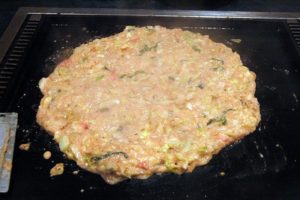
Photo Credit: Jpatokal, licensed under the Creative Commons Attribution-Share Alike 3.0 Unported license. Source: https://en.m.wikipedia.org/wiki/Monjayaki
When the batter and ingredients are delivered to you, pour it onto the griddle. It spreads all over the place and you add your ingredients. Everyone at the table gets a small spatula. You cook it all together, each one mixing it as they choose.
Oh, why did I say this was intellectual as well as fun? One restaurant owner shared the oral tradition to my group that students often came to eat and practice kanji, drawing the characters in the cooking batter and seeing who could make the best ones. So the name comes from the Japanese word for “character,” “mon.” You really need to try that method for improving your Japanese!
As it cooks, it takes on the consistency of cooked melted cheese. Most people agree that the crispy parts are the best. Each of you decide what you want to eat and when, because you use your own small spatula to serve yourself. It really tastes great, and somehow, the old street, the old buildings and the history combine with the fun you’re having with friends to all become part of the taste!
I give Monja, ⭐⭐⭐ ⭐⭐ ( 5 stars)! I’d say that if you are in Tokyo and have the chance, this is an absolutely must try. If you want to show off your kanji (or even your hiragana is okay!), have fun with friends and try a great food, come to Tsukishima’s Monja Dori and try Monjayaki. Oh, and you can invite me too!
Photo Credits:
Top Photo: “Monjayaki” by Masaaki Komori from Tokyo, JAPAN licensed under the Creative Commons Attribution-Share Alike 2.0 Generic license (CC BY-SA 2.0). No changes or alterations made. Wikimedia Commons Link
Additional photo: “Monjayaki After” by Jpatokal licensed under the Creative Commons Attribution-Share Alike 3.0 Unported license (CC BY-SA 3.0). No changes or alterations made. Wikimedia Commons Link
All other content (text) created by the original author and © 2021 MUSUBI by Borderlink
Top photo by Darklanlan , used under the Creative Commons CC0 1.0 Universal Public Domain Dedication. (CC0 1.0) No changes or alterations were made. Wikimedia Commons Link
MUSUBI presents a personal story from one of our writers about their job search while they were still studying in Japan, and their transition from language student to Assistant Language Teacher.

Photo by Andrew Neel on Unsplash
Anyone who has tried finding employment knows how terrible it can feel when you are unable to find a job. Now take that feeling and imagine going through it while living in another country.
When I was a university student studying here in Japan, I remember being terrified of applying for jobs as the day of my graduation grew closer. The fear I had of being rejected held me back from applying for the positions I wanted, and the fear of my visa running out before I could find something was equally crushing.
To compound matters further, a large part of me knew I would have a difficult time finding a job here. At the time, my Japanese wasn’t great and I didn’t have enough experience for the jobs I was looking at. I knew there were companies out there that didn’t require me to have much experience or be fluent in Japanese, but they were difficult to find. “Hopeless” doesn’t begin to describe how I felt as the clock was ticking down.
And then, I hit a lucky break. While a student in university, I had held many part time jobs working both as a private teacher and as a teacher in small language schools. I have always enjoyed working with young learners, and I just find teaching to be a lot of fun. After a couple of months of searching for jobs, I decided to look into teaching work, and came across a job ad for an Assistant Language Teacher position, and I applied right away.
When I saw the ad, I was immediately drawn to the idea of being an English teacher in a public elementary school. As mentioned, I had enjoyed teaching kids, and doing that full-time seemed like a good way to build off of what I had already experienced while simultaneously improving my skills.
Another reason that job appealed to me was that I wanted to work alongside Japanese people and be able to use my Japanese. Even if the classes themselves are conducted all in English, I could use Japanese when speaking with teachers or other school staff. Working in the real world of a public school setting makes this possible, as there’s always someone to talk to.
I have been an ALT for almost two years now and I have taught in five schools. In every school I worked in. I’ve always enjoyed interacting with both the school faculty and the students. Many Japanese students are very enthusiastic when learning English. The kids have such a great kind of energy when they are in the class, and that energy remains even outside the class. I often play or talk with the students during their breaks, and it keeps me ‘tuned in’ to my work. I can safely say that this job never gets dull or boring, because the students are always around to keep things interesting.
Not only are the students fun to teach and interact with; the teachers are also very nice and approachable. They always try and interact despite the language barrier. When I first started out being an ALT, I was worried that I wouldn’t be able to interact with the other teachers much; however this is not the case. In all five schools I have taught in, the teachers have always tried there best to talk with me, in both English and Japanese. Although it was difficult at first, over time my Japanese has improved and I am much more comfortable now when it comes to speaking with other teachers. Being an ALT has really helped me learn more about both the Japanese language and culture.
What advice would I give to others who will go through (or are going through) my situation? Start your job search as early as possible. It can seem strange to start applying for jobs months before you expect to graduate, but it’s actually very smart. Teaching jobs especially tend to hire year-round, and even if you aren’t available now, you might be in time for the start of a new school year. It’s never too early to start applying and doing interviews, but there will be a point where it’s too late. I was lucky enough to find the perfect job for me when I did, but I wouldn’t recommend that kind of last-minute scramble. There’s a reason the saying is “the early bird gets the worm”.
Being an ALT definitely has had its share of difficulties, but it also has benefits as well. The hours and pay are generally pretty good for the work that is required from an ALT. The work is fulfilling personally, and being an ALT has been a lot of fun. I feel like I’ve grown as a teacher and as a person. Working with Japanese kids can really help improve ones’ instructional abilities, and working in a public school environment has helped my Japanese language skills. For anyone currently studying here who is looking to their perfect next step in Japan, I highly recommend looking into becoming an ALT.
Ready to apply for your ALT adventure? Now’s the time! For more information, read all about being an ALT!
Photo Credits:
Top photo by Darklanlan , used under the Creative Commons CC0 1.0 Universal Public Domain Dedication. (CC0 1.0) No changes or alterations were made. Wikimedia Commons Link
Additional photo: Andrew Neel on Unsplash
All other content (text) created by the original author and © 2021 MUSUBI by Borderlink
Top photo: Hiroyoshi Urushima on Unsplash
Living in Japan and thinking about owning a car? One the one hand, this can be great! It opens up many doors, allowing convenience and efficiency. But buyer beware: Owning a car in Japan is expensive! More so if you live in the city than the countryside though; car ownership is generally not recommended for city-dwellers. The trains are just way too convenient.
However, if you intend to take the leap and get the car of your dreams or just one to get you from point A to point B, here is our guide to the good, bad, and ugly of auto ownership in Japan.
The Good
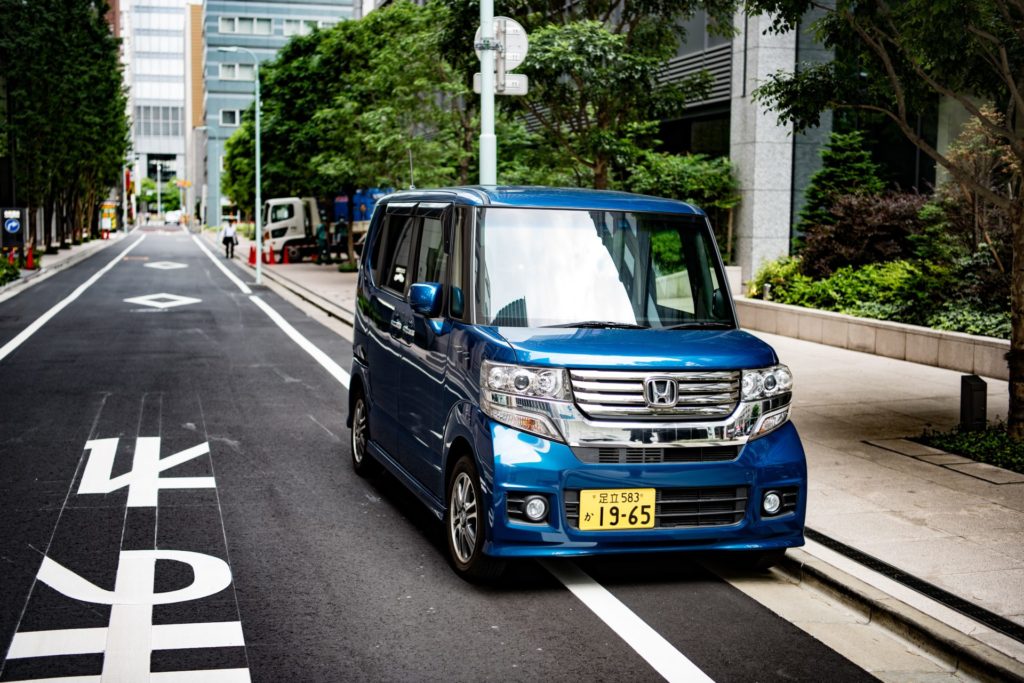
Photo by Daniel Klein on Unsplash
With a personal vehicle, you have the convenience of being able to go wherever you want, whenever you want, in comfort. No worries about catching the last train or riding the crowded trains during long holidays, for that matter. You can go nuts at the grocery store and stock up without worrying about how to carry the groceries home.
And face it, Japan has beautiful landscapes that should be experienced through a car window; with friends, family or alone. You can pull over, take a picture and continue on your journey. Trains are nice, but nothing beats a good drive. Also, there is no other way to experience the Japanese highway service areas than by car or bus. Some of the service areas are just amazing. Think convenience stores but 100x better.
Despite the narrow roads, tight corners, and different rules, having your own car is another level of freedom that will give life in Japan more depth. But know that it will come at a cost.
The Bad
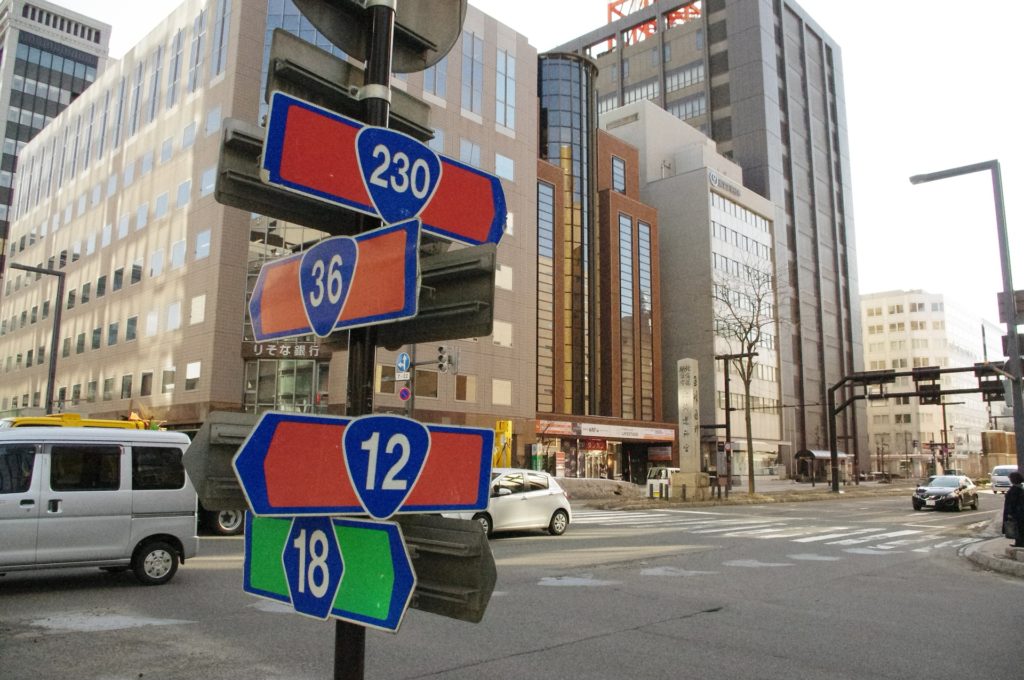
Photo by May_hokkaido on Pixabay
You are probably excited and ready to settle on that little hatchback, rugged SUV or dare I say, sporty K car with the turbo. I should warn you about a few things: Toll roads are everywhere; Neither parking nor gas is cheap.
On any trip, toll fees, parking, and gas are always on my mind. It is nice to explore new places and drive around, but depending on the distance and location, a weekend getaway can cost more than the accommodations alone. Almost all express routes in Japan are toll roads. I have yet to encounter free parking aside from hotels and malls.
Furthermore, (at the time of writing this article) gasoline costs about ¥150/ L (USD 6/ Gallon). A 3-4 hour return trip using the highway can be costly. You can always negate the cost of the highway tolls by using local roads, but it can be physically taxing. If you absolutely must use toll roads, an ETC card is definitely something you should get. There are many discounts available for ETC card users. Even after all of this, you may still be thinking: “It’s not about the money, it’s about the memories”. Sorry to burst the bliss bubble, but the car fee frenzy doesn’t stop there.
The Ugly
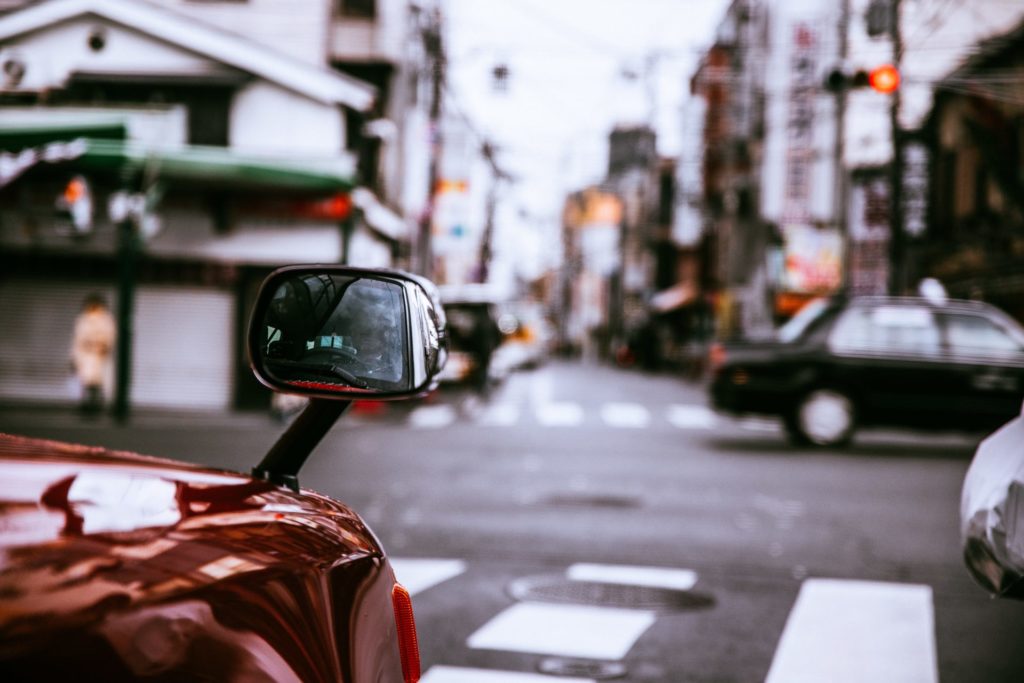
Photo by Zachariah Hagy on Unsplash
Hopefully, the reality of owning a car is starting to settle in. I didn’t want to start with the nitty-gritty details because I feel that this might turn you off completely. And rest assured, once you know what you’re in for, and weigh it against the benefits, owning a car will indeed be worth your while. With that said, it is time for the harsh reality of car ownership. Let’s start with the taxes! Deep breath.
Depending on the size of your engine and the type of car you drive, the amount of tax you pay will change. The annual automobile tax can cost anywhere from ¥5,000 for a Kei car to ¥66,000 for something with a bigger beefier engine. FYI, Kei cars are the little cars you see with the yellow license plates. They are generally cheaper to drive but much slower, have smaller engines, and have a limited crumple zone. Generally, Kei cars are ideal for light drivers. Unless you get the sporty types. Those are just fun.
Next, is the shaken, pronounced ShAh-Ken. This is the mandatory maintenance cost for car ownership. It is basically to ensure that your vehicle is working and not creating more pollution than allowed. Once again, Kei cars will cost you less; roughly ¥70,000 to ¥100,000. Vehicles with a white license plate will cost anywhere from ¥80,00 and up. Also, shaken needs to be renewed every 2 years. If your car is brand new out of the dealership, shaken is due for renewal on the third year after the car was manufactured. So, remember to put a little bit of cash away every month, so you aren’t in a tight spot when the wonderful day of shaken arrives!
I always thought it was strange that the price does not relate to the actual state of your vehicle. Or the overall condition. Minus your repair costs, it seems to be a standardized amount. But, I digress.
You also need to pay for insurance. How could I forget! Starting at ¥20,000/ year for Kei car owners. This amount can increase depending on several factors: Your car, driving history, age, …etc. There are many different insurance companies around that offer different packages, so be sure to shop around. This is where knowing Japanese or having a good Japanese friend really comes in handy.
Next on the list of costs, is maintenance. “But wait!” you say. “I thought shaken was maintenance!”. Unfortunately, shaken is not maintenance. So, you should definitely prepare for it. This would include, oil changes, cleaning, repairs and anything else that happens in the time between shaken. A properly maintained car will most likely have a lower shaken cost. It will also break down a lot less. You don’t want your car to break down. Do you?
Last but not least and probably the most important thing to note: Before a dealer will let you drive off the lot in your new car and obtain ownership, you must prove that you have a place to put the vehicle. This means having a parking space. Depending on where you live, the price of parking can be free or upwards of¥20,000! You usually need to have the space ready and the police will come and inspect it to see if it is suitable for your vehicle. If you don’t have a parking space already, then you will need to look for one. You may even have to pay the first two months of rent for the parking space as well.
Conclusion

Photo by takahiro taguchi on Unsplash
That is about all you should know about owning a car in Japan. As you can see, it is very costly and you should definitely consider these things before you buy or lease your vehicle. I say all this not to discourage you though, but to prepare you for he realities. Before you take the plunge, be sure to do your homework. Find the kind of car that fits your needs. If you have the luxury, find the place to live that best fits your car.
As mentioned, if you live out in the country, car ownership is a huge benefit and worth the investment. I have had my car for about 4 years and drive as much as I can because I love driving. I wouldn’t trade it for anything, and there are millions of others just like me living here. Cars are a great tool and give you an added level of independence in Japan. Just remember, independence can be pricy, so be smart, plan ahead, and get ready to enjoy the freedom of the open road!
Photo Credits:
Top photo: Hiroyoshi Urushima on Unsplash
1 – Daniel Klein on Unsplash
2 – May_hokkaido on Pixabay
3 – Zachariah Hagy on Unsplash
4 – takahiro taguchi on Unsplash
All other content (text) created by the original author and © 2021 MUSUBI by Borderlink
Top Photo: Esperanza Doronila on Unsplash
The quiet, rural prefecture of Yamanashi is known for its fruit and local dishes rich in thick noodles, pumpkin, and beef. But there is an unofficial second cuisine to this region: Indian food. As (quite literally) billions of people around the world know, Indian food is amazing, filled with bold and memorable flavors.
And best of all, it’s incredibly cheap in Japan, with a meal that leaves you stuffed rarely costing more than 1500 yen. No one understands this better than Yamanashi, where Indian food has taken root even more firmly than elsewhere in Japan. In this article, we’ll take a look at why Yamanashi can’t get enough of curry, and the best places to find some around Kofu, Yamanashi’s capital city.
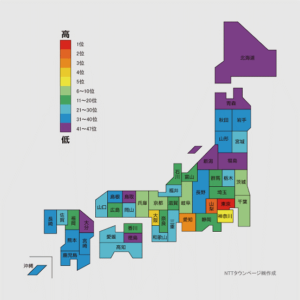 According to an analysis by NTT, Yamanashi prefecture has the second most Indian restaurants per capita in all of Japan, at 2.51 restaurants per 10,000 residents, beaten only by Tokyo at 3.6 per 10,000 and putting them well ahead of third place Aichi at 2.16 per 10,000.
According to an analysis by NTT, Yamanashi prefecture has the second most Indian restaurants per capita in all of Japan, at 2.51 restaurants per 10,000 residents, beaten only by Tokyo at 3.6 per 10,000 and putting them well ahead of third place Aichi at 2.16 per 10,000.
It’s no surprise that the nation’s capital and largest city on the planet is a hub of foreign cuisine, but Yamanashi? It’s a rural, somewhat isolated prefecture, one where it’s not uncommon to go two weeks without encountering another foreigner. And yet Indian food is indeed a ubiquitous part of life here; one cannot spend any time in Kofu or its neighboring cities without spotting the familiar sights of orange signs, Indian and Nepali flags, and little statues of Ganesh.
So how does Yamanashi beat out metropolitan areas like Osaka or Fukuoka? “Yamanashi is hot just like India”, a coworker speculated when asked. Though it’s not a subject that has received much attention or research, from what I’ve been able to gather, a fairly large number of South Asians have been attracted to this region to work in Kofu’s precious gems industry, the largest in Japan. This influx of South Asians, some of whom naturally open shops to sell their country’s cuisine, coupled with Yamanashi’s low population, creates this surprising statistic.
So now we know where this large supply of Indian food comes from, but where are the best places to get it? Here are my top 3 picks:
Milan ミラン
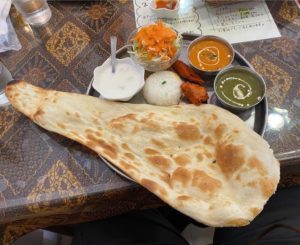 In just about any Japanese city, the best place to look for good food is around the main station. Located about 15 minutes’ walk south of Kofu station, Milan is a solid place to try Indian food. Though unassuming from the exterior, there’s plenty of room inside, with its 4-6 person tables perfect for a group meal with friends or coworkers.
In just about any Japanese city, the best place to look for good food is around the main station. Located about 15 minutes’ walk south of Kofu station, Milan is a solid place to try Indian food. Though unassuming from the exterior, there’s plenty of room inside, with its 4-6 person tables perfect for a group meal with friends or coworkers.
The drinks are cheap, and the menu has a good balance of classics like butter chicken curry and tikka masala, coupled with more experimental choices like pumpkin and eggplant curries and vegetable naan, options I have yet to see elsewhere. Whether you’re conservative in your food preferences or looking to be a little adventurous, Milan has something for you.
New Mahal ニューマハール
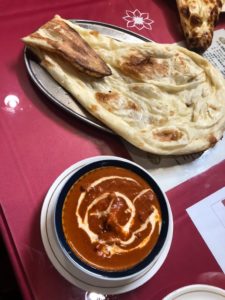 Located just across the street from Kofu station’s North exit, New Mahal is the most convenient and accessible option on this list to any visitor in Yamanashi. It also has the largest and most diverse menu of any South Asian restaurant I’ve ever seen.
Located just across the street from Kofu station’s North exit, New Mahal is the most convenient and accessible option on this list to any visitor in Yamanashi. It also has the largest and most diverse menu of any South Asian restaurant I’ve ever seen.
While the owners are Nepali, and thus your traditional Indian-Nepali curries and tandoori dominate the menu, they also offer a selection of Thai and Vietnamese dishes, mainly seafood based. They offer reasonably priced set meals as well as unlimited “tabe-houdai” options This restaurant is expansive, with plenty of long tables, ensuring you’re unlikely to wait long for a table, even if you bring a group. Definitely a great choice for someone who has just arrived or is about to leave Kofu station.
Namaste ナマステ
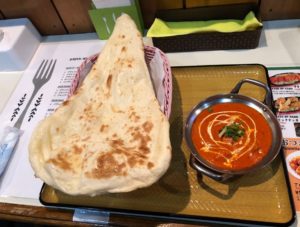 This is my personal favorite and top recommended curry restaurant. Located in the quiet district of Arakawa, on the border between Kofu and Kai municipalities, Namaste may be a little more difficult to reach without transportation, but is well worth the trip. The menu is fairly small in terms of curry selection, but all the options are delicious, and they have the best selection of naan varieties, including a garlic cheese fusion and sesame.
This is my personal favorite and top recommended curry restaurant. Located in the quiet district of Arakawa, on the border between Kofu and Kai municipalities, Namaste may be a little more difficult to reach without transportation, but is well worth the trip. The menu is fairly small in terms of curry selection, but all the options are delicious, and they have the best selection of naan varieties, including a garlic cheese fusion and sesame.
The portions are large, and their cheese naan in particular is the best I’ve ever had. The setting is more intimate than the other restaurants on this list, with a mixture of both small ordinary tables and Japanese style short tables on tatami floors, perfect for a date or outing with a close friend. Namaste is, in my opinion, Kofu’s best kept secret, and well worth a visit to any visiting or settling in the area.
While Japan remains a largely homogenous country, foreign foods still manage to leave a striking impact on local culture and identity. No visit to Aomori is complete without a stop at a French restaurant, Yokohama and Nagasaki are defined by their robust Chinese offerings, and in Yamanashi, particularly the capital of Kofu, it is curry that’s king. Whether you’re working in the area or just stopping by for some sightseeing, give one of these restaurants a chance. You won’t be disappointed.
Photo Credits:
Top Photo: Esperanza Doronila on Unsplash
*First image comes from NTTタウンページ
“破竹の勢いで増加しているインド料理店は、どの県に多いの?”
Additional photos were provided by Jacob Newcomb, used with permission.
All other content (text) created by the original author and © 2021 MUSUBI by Borderlink
Top photo: Okayama Red Cross Hospital, Kita-ku, Okayama by Phronimoi, licensed under the Creative Commons Attribution-Share Alike 3.0 Unported, 2.5 Generic, 2.0 Generic and 1.0 Generic license. No changes or alterations were made. Wikimedia Commons Link
Accessing appropriate healthcare in Japan can be a challenge for foreigners new to the country. This article will guide you through the steps you need to take to make that process as smooth as possible.
Step one includes obtaining health insurance, without which you will be paying full medical fees. Step two guides you through the process of accessing an initial consultation at a clinic. Step three deals with treatment at hospitals and registering at a pharmacy.
Think of this article as a companion piece to our previous guide and if you’re about to enter into the healthcare system yourself for the first time, we hope it helps.
Step one: Health insurance
Anyone living in Japan must be covered by an insurance scheme. If you are a full time employee it is likely that you will be enrolled on a company insurance scheme (健康保険 kenko-hoken), in which case you will be issued a health insurance card (健康保険証 kenko-hoken-sho).
However, if you are unemployed, part-time, or do not receive company healthcare insurance, you must obtain National Health Insurance (国民健康保険 kokumin-kenko-hoken) from your local city hall (市役所 shi-yaku-sho). For the application you will need your passport, residence card, a your own personal seal/stamp (判子 hanko).
If you do not have a “my number” card, you can apply for this at the city hall. Once issued, you should keep your insurance card on you at all times.
Step Two: Registering at a clinic
Unlike many other countries, there is no system of general practitioners in Japan, therefore, unless it is an emergency, you must first register with an appropriate clinic if you become ill. This will involve an initial consultation (初診 sho-shin). Here are the main type of clinics:
眼科 (ganka) ophthalmologist
歯科(shika) dentist
耳鼻咽喉科(ji-bi-in-ko-ka) ear, nose and throat
内科 (naika) internal medicine
外科 (geka) surgery
皮膚科 (hifuka) dermatologist
Firstly, go to the reception and tell them it is your first time at the clinic by using the phrase hajimete desu, and present your health insurance card. The receptionist will ask you to fill in a medical questionnaire (問診票 mon-shin-hyo ) which includes general information about yourself. After you complete this and return it to the receptionist, you will then be issued a medical card (診察券 shin-satsu-ken).
The doctor will call you into the examination room for the initial consultation. Some clinics have English speaking doctors, however this is not always the case. If you can’t speak Japanese it’s probably best to take someone with you who can translate. However, if this isn’t feasible, here are some survival phrases:
歯が痛い ha ga itai my tooth hurts
お腹が痛い o-naka ga itai my stomach hurts
足が痛い ashi ga itai my leg hurts
頭痛がします zutsu ga shimasu I have a headache
めまいがします memai ga shimasu I am dizzy
吐き気がします hakike ga suru I feel sick
下痢をします geri o shimasu I have diarrhea
便秘をします benpi o shimasu I have constipation
咳が出る seki ga deru I have a cough
鼻血が出る hanaji ga deru I have a nosebleed
熱がある netsu ga aru I have a fever
After you have received a consultation, the doctor will advise you and the best course of action.
This is likely to be one of two outcomes. Either referral to a hospital for further treatment, and/or a prescription for medications.
Step three: Hospital or pharmacy
If the illness requires medical attention in hospital then you will be given a referral letter (紹介状 sho-kai-jo). Hospitals in Japan operate by appointment, hence you should make an appointment before you attend even if you have a referral letter. When you attend you must present your referral letter to the receptionist along with your health insurance card. Again, once you have registered with the hospital you will receive a medical card.
If you are sent to a pharmacy you must register with that pharmacy and present your prescription along with your health insurance card. Once you have registered with that pharmacy you will receive a pharmacy medical card and your prescriptions. In either case, because your insurance covers only 70% of any treatment or consultation fees, you should take cash to over any additional expenses.
Accessing healthcare in Japan can be a daunting challenge for foreigners who are new to the country. However, this angst can be avoided with a little preparation and planning. With the correct documentation, and a little vocabulary under your belt, you should find accessing healthcare relatively painless.
Photo Credits:
Top photo: Okayama Red Cross Hospital, Kita-ku, Okayama by Phronimoi, licensed under the Creative Commons Attribution-Share Alike 3.0 Unported, 2.5 Generic, 2.0 Generic and 1.0 Generic license. No changes or alterations were made. Wikimedia Commons Link
All other content (text) created by the original author and © 2021 MUSUBI by Borderlink
Top Photo: Vicky Ng on Unsplash
Have you ever wondered what art tastes like? It’s time to live that fantasy by trying wagashi – traditional Japanese confectionery sweets. These delightful treats are made from seasonal ingredients and serve as the perfect companion to a relaxing cup of tea.
But where can one find these delectable works of edible art in Tokyo? We got you! Here are our top five picks of amazing wagashi tea houses and cafes that are sure to provide you with the luxury experience of consuming fine art.
1) Funabashiya, Kameido
Located near Kameido Tenjin Shrine, a spot known for its seasonal flowers that bloom all year round, this tea house serves an array of wagashi dishes on its menu. But having a serene atmosphere near a beautiful shrine isn’t all they have to offer. The best thing about their menu is that they incorporate the seasonal flowers you see in the shrine into their sweets. They are especially known for their wisteria-infused wagashi dishes, so be sure to check them out from mid-April to mid-May – the peak of wisteria season in Japan.
2) Tsuruya Yoshinobu Tokyo Mise
Fascinated by the process of art more than the final product? Then this is the place for you! The Tokyo branch of this Kyoto-based tea house offers you the opportunity to witness beautiful delicate wagashi crafted right before your very eyes. Not to mention, Tsuruya Yoshinobu has been refining its craft for more than two hundred years. No wonder why they once served the Kyoto Imperial Palace and grand tea masters.
3) Aoya-No-Tonari
This cozy family-owned café also infuses traditional flavors from Kyoto into their wagashi. They are known for their simplistic approach to the craft that relies on texture, quality natural ingredients, and skill. They also serve healthy cookies that do not use preservatives, additives, or white sugar. A must-try if you’re in Tokyo!
4) Akasaka Aono
Still going strong for over a century, this famous shop is known for its bestselling Akasaka mochi, made with walnuts and brown sugar. Simple and flavorful, these traditional confectionery sweets are perfect as gifts, or for you to treat yourself to an experience like no other.
5) Ginza Fugetsudo
Sophisticated and elevated, this tea house prides itself with freshly made wagashi that embodies luxury. Every season offers a different experience to their guests, so be sure to pay them a visit all year round! They even serve homemade herbal tea for guests to elevate their wagashi experience. But be sure to make an order as this tea house only makes wagashi as per request. However, if you’re up for it, you can always just drop by for their seasonal kakigori – Japanese shaved ice dessert, that’s just as gorgeous as their wagashi.
There you have it! Five places to live your fantasy by tasting art and enjoying traditional Japanese culture. Let us know which of these tea houses or cafes gave you the best experience, and don’t forget to check out our other blog posts for more insights on Japanese culture and cuisine!
Photo Credits:
Top Photo: Vicky Ng on Unsplash
All other content (text) created by the original author and © 2021 MUSUBI by Borderlink
